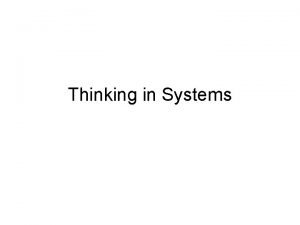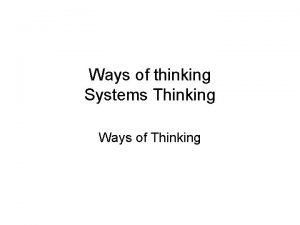Thinking in Systems Introduction Systems Thinking The only

















- Slides: 17

Thinking in Systems Introduction

Systems Thinking • The only way to fully understand why a complex problem occurs and persists is to understand the part in relation to the whole (O'Connor & Mc. Dermott, The Art of Systems Thinking: Essential Skills for Creativity and Problem. Solving) • Traditional scientific approach = isolating small parts of the system • Systems thinking = taking many interactions into account

Systems thinking is needed for problems that are: • Complex problems that involve helping many actors see the "big picture" and not just their part of it • Recurring problems or those that have been made worse by past attempts to fix them • Issues where an action affects (or is affected by) the environment surrounding the issue, either the natural environment or the competitive environment • Problems whose solutions are not obvious http: //www. thinking. net/Systems_Thinking/Intro_to_ST/intro_to_st. html

Example: Obesity

Societal policies and processes influencing the population prevalence of obesity INTERNATIONAL FACTORS NATIONAL/ REGIONAL Transport Globalization of markets Urbanization Health COMMUNITY LOCALITY Public Transport Public Safety Health Care Development Social security Media & Culture Media programs & advertising Education Media Food & Nutrition National perspective Sanitation System Manufactured/ Imported Food Agriculture/ Gardens/ Local markets WORK/ SCHOOL/ HOME INDIVIDUAL POPULATION Leisure Activity/ Facilities Labor Energy Expenditure Infections Worksite Food & Activity Family & Home Food intake : Nutrient density S I T Y O % P OBESE R EOR V A UNDER LWT E N E School Food & Activity Modified from Ritenbaugh C, Kumanyika S, Morabia A, Jeffery R, Antipathies V. IOTF website 1999: http: //www. iotf. org


Diane T. Finegood, Thomas D. N. Merth and Harry Rutter Implications of the Foresight Obesity System Map for Solutions to Childhood Obesity. . Obesity (2010) 18, S 13–S 16. doi: 10. 1038/oby. 2009. 426

Example: Policy Development 1. Agenda setting (Problem identification) 2. Policy Formulation 3. Adoption 4. Implementation 5. Evaluation http: //en. wikipedia. org/wiki/Policy

Policy Subsystem System-wide with enduring/constraining effect External Events - Change in socioeconomic conditions, public opinion, leaders - Policy decisions/impacts from other subsystems Constraints & Resources Relatively Stable Parameters Coalition A Coalition B Policy beliefs Resources Strategy Decisions by Governmental Authorities Policy Outputs & Impacts Adapted from: Breton E, Richard L, Gagnon F, Jacques M, Bergeron P. Health promotion research and practice require sound policy analysis models: The case of Quebec’s Tobacco Act. Social Science & Medicine 2008; 67: 1679 -1689. 5 The Advocacy Coalition Framework

Problem stream No policy adoption Policy stream B Policy Stream Politics stream Politics Stream Scenario 1: No Coupling of Streams or Window Closed > Policy Proposal Not Adopted Problem stream Policy Stream Politics stream Politics Stream Scenario 2: Coupling of Streams and Window of Opportunity Open > Policy Proposal Adopted Kingdon’s Multiple Streams Model 2 Policy Adoption

Solutions to Complex Problems • Consider that individuals matter • Match capacity to complexity • Set functional goals & directions for improvement • Distribute decision, action and authority • Form cooperative teams • Create competition& feedback loops • Assess effectiveness Diane T. Finegood, Thomas D. N. Merth and Harry Rutter Implications of the Foresight Obesity System Map for Solutions to Childhood Obesity. . Obesity (2010) 18, S 13–S 16. doi: 10. 1038/oby. 2009. 426

Many Forms of System “Maps” Environmental Risk Factors Mixed Income Housing Demographic Risk Factors Social Networks Food Access: 1 Physical 2 Financial 3 Nutritional 4 Cultural Food Security

Healthy People 2020

Ecological Framework for Influences on What People Eat

Examples from Leischow Paper

Today’s Work 1. List – Ways in which public health nutrition can help to reach HP 2020 goals 2. Analyze one nutrition problem that is related to both healthy food access and HP goals. • • Draw a picture of the system that influences that problem. Indicate at least 4 potential places in the system where public health might make a difference.

Do Exercise Make System Maps for your specific case
 Take only photographs leave only footprints
Take only photographs leave only footprints Thinking that only westerners are skilled enough
Thinking that only westerners are skilled enough Hình ảnh bộ gõ cơ thể búng tay
Hình ảnh bộ gõ cơ thể búng tay Slidetodoc
Slidetodoc Bổ thể
Bổ thể Tỉ lệ cơ thể trẻ em
Tỉ lệ cơ thể trẻ em Voi kéo gỗ như thế nào
Voi kéo gỗ như thế nào Chụp phim tư thế worms-breton
Chụp phim tư thế worms-breton Chúa yêu trần thế
Chúa yêu trần thế Các môn thể thao bắt đầu bằng tiếng bóng
Các môn thể thao bắt đầu bằng tiếng bóng Thế nào là hệ số cao nhất
Thế nào là hệ số cao nhất Các châu lục và đại dương trên thế giới
Các châu lục và đại dương trên thế giới Công thức tiính động năng
Công thức tiính động năng Trời xanh đây là của chúng ta thể thơ
Trời xanh đây là của chúng ta thể thơ Mật thư tọa độ 5x5
Mật thư tọa độ 5x5 101012 bằng
101012 bằng độ dài liên kết
độ dài liên kết Các châu lục và đại dương trên thế giới
Các châu lục và đại dương trên thế giới

































